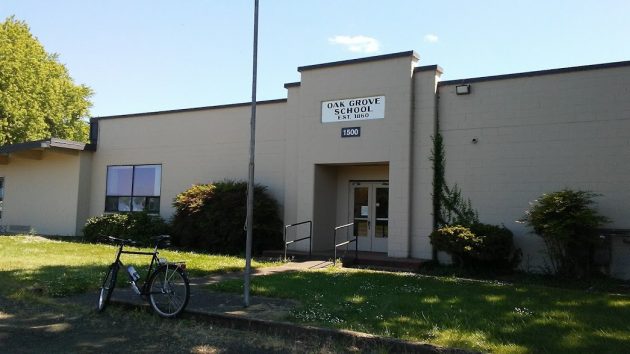
This hasn’t been the front door of Oak Grove School for a long time.
If you want to take a last look at Oak Grove School in rural North Albany, better make it quick. The building will be demolished shortly, to be replaced by a much bigger one that’s scheduled to be ready in the fall of 2019.
It is one element in the Albany school district’s $187 million capital construction program now under way. (Voters approved $159 million in bonds in May 2017. The state added a $6.9 million grant, and the bond sale yielded an additional $28.5 million.) (*This doesn’t add up. See the explanation in the comments below.)
The elementary school at 1500 Oak Grove Drive N.W. has been around since 1860, and the current building dates from 1948. Russ Allen, business director for Greater Albany Public Schools, told me that additions or other improvements were made in ’57, ’67, ’74, and again about 10 years ago. The original plan had been to remodel and enlarge Oak Grove again, but then the school board decided it was more economical and prudent to build a whole new school.
Gerding Builders of Corvallis, the low bidder, has been awarded the contract to oversee the Oak Grove replacement and has been getting bids from prospective contractors for different aspects of the work. Demolition and other site work are to start shortly after the last day of school, which is June 14. The board awarded a $2.16 million contract for that work last week.
The overall Oak Grove replacement project — classrooms, administrative offices, gym, cafeteria, parking for staff and visitors, everything — has been estimated to cost around $26 million.
The new school, with a two-story classroom wing, will have room for 400-500 pupils, compared to the current enrollment of about 290. You can look at the architects’ renderings on the school district website here.
On its 8.3-acre site, the present school tucks neatly into the surrounding farmland. We’ll see whether the larger, two-story replacement will manage the same when it’s done. (hh)

Like the rest of the buildings, this current main entrance will disappear.

When was the building built?
From the article:
“The elementary school at 1500 Oak Grove Drive N.W. has been around since 1860, and the current building dates from 1948. Russ Allen, business director for Greater Albany Public Schools, told me that additions or other improvements were made in ’57, ’67, ’74, and again about 10 years ago.”
By my rudimentary math, the total ($159 + $6.9 + $28.5) comes to $194.4. Is there some higher level math going on behind the scenes? Also, was the total amount anticipated by the district, or does the amount in excess of $159 represent a windfall of sorts? Inquiring minds want to know…
I ignored Rule 1, which is to do the arithmetic before repeating numbers. The state grant evidently was not counted in the school district’s summary of the funding. If there’s a further explanation, I’ll get it and pass it on. Thanks. (hh)
Here is the better explanation: While voters approved $159 million in bonds, the school board had said it would levy less in taxes if a grant came in. So when the state granted nearly $7 million toward capital construction, the district sold only $152 million worth of bonds. That, plus the grant, plus the premium gained in the bond sale, yields a $187 million school modernization and construction program. GAPS will amend its bond program website to make this clear. Thanks again for pointing out the discrepancy. (hh)
The only way you get a premium is to set an interest rate higher than necessary so the bonds sell at a premium. In my opinion the premium should be set aside and used to pay off the bonds otherwise the taxpayers are getting screwed as they only approved a bond issue of 159 million.
The premium arose because the school district paid a higher interest rate than necessary to sell the bonds; therefore the premium should be used to pay back the bonds otherwise the taxpayers are getting screwed.
So Hasso please address Al’s issue. Voters approved only 159M. Seems something smells like distortion/manipulation when voter did not approve 187M. Schools that do a poor job education now get more greedy.
As I understand it, taxpayers got a break. We’ll have to pay off “only” $152 million, not $159 million. And because buyers were so eager to bid on these bonds that they paid more to get them, we get more projects than with the original bond amount authorized. What’s not to like?
Spot on Hasso…
The premium comes because the taxpayers will have to pay back the premium because of a higher interest rate on the bonds than was necessary to sell them at par. Check it out with any bond expert. Don’t take my word.
You apparently don’t like me posting but there are no free lunches in the world except those paid by the government. The taxpayers will be paying a higher interest rate than necessary to cover the premium the bond buyers paid.
I wish Jerry Andrus was still here to explain how this pea and shell game really works